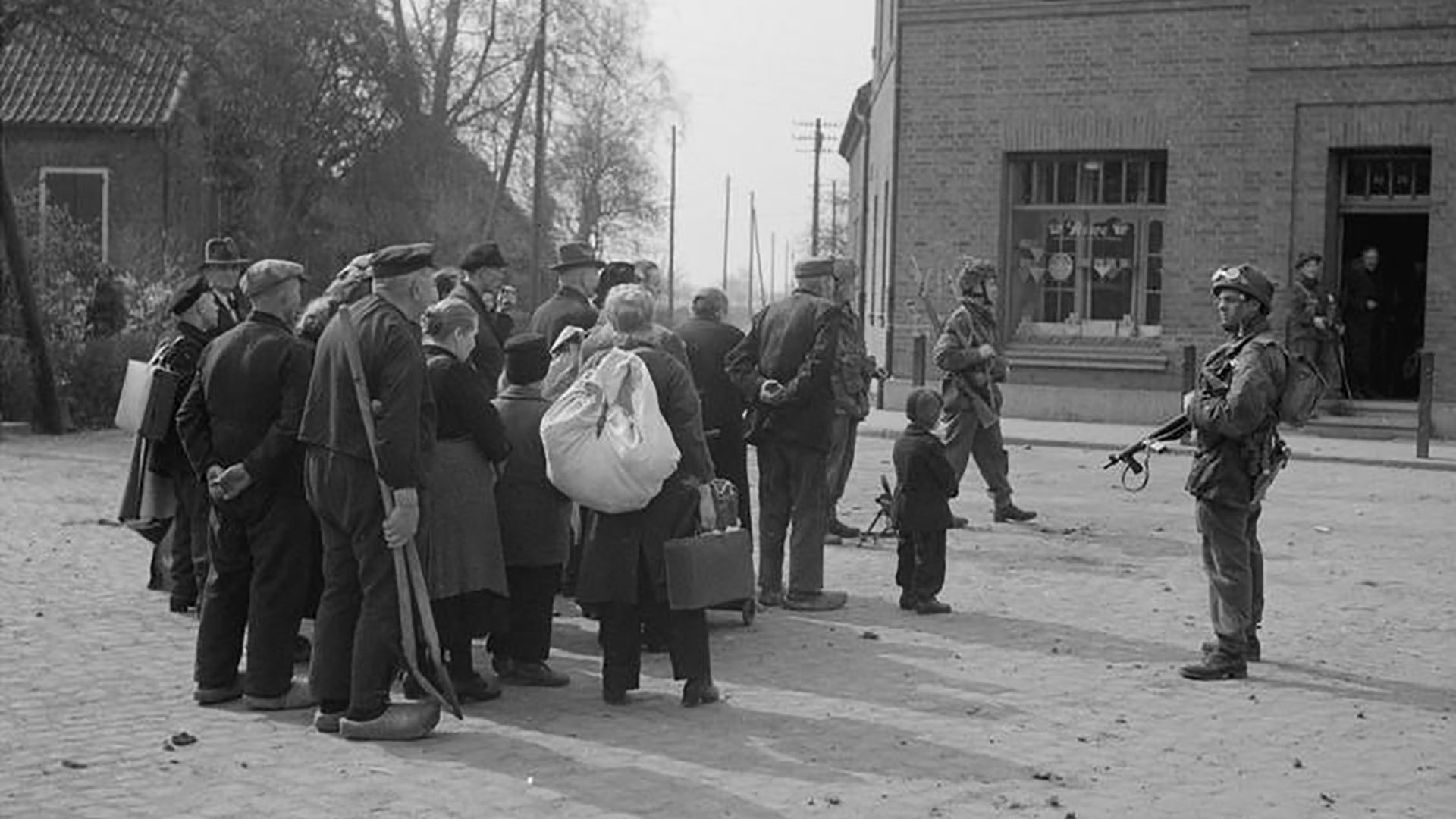On 24th March 1945, 1st Battalion Royal Ulster Rifles took part in Operation Varsity. The operation was the largest airborne attack in history conducted on a single day in a single location. As part of the larger Operation Plunder, a total of more than 16,000 airborne troops and several thousand planes and gliders made up the combined British and American forces.
The aim was to land the British 6th Airborne Division and the US 17th Airborne Division in Germany to secure a foothold over the Rhine. The British Division would secure the villages of Hamminkeln and Schnappenberg and take 3 bridges over the River Issel. 6th Airborne Division totalled 7,2220 personnel, 42 Douglas C-54s, 752 C-47 Dakotas, 420 Airspeed Horsa Gliders and General Aircraft Hamilcar Gliders. Troops began landing soon after 1000hrs on 24th March 1945.

Imperial War Museum Photo: CH 14889 (Part of the Air Ministry Second World War Official Collection). General Aircraft Hamilcar heavy gliders lined up at Woodbridge, Suffolk, for the evening take off for the assault on the Rhine. In the foreground a ground crew member checks the attachment of the tow rope on a glider. Photo taken by Flight Lieutenant Miller - Royal Air Force Official Photographer.
In March 1945, Lieutenant Colonel Robert John Heyworth “Hank” Carson was Commanding Officer of 1st Battalion Royal Ulster Rifles. The month began with the Battalion on leave in Bulford, Wiltshire where they began training until 20th March 1945. From there, they moved to a transit camp before arrival at Chadacre on 21st March 1945 where final preparations for Operation Varsity took place. On 24th March 1945, the Battalion took off at 0715hrs from Gosfield, Essex and Operation Varsity was underway.
Operation Varsity
1st Battalion Royal Ulster Rifles was part of 6th Airlanding Brigade under the command of Brigadier Hugh Bellamy. Shortly after 1020hrs, they landed in Landing Zone LZ-U capturing their objectives rapidly. The Rifles’ particular objectives were to seize the bridge over the Issel at Hamminkeln, take the railway station and level crossing, and prevent enemy counterattack from the south-east.
A Company under the command of Major Charles Vickery landed at LZ U2 and seized the Ringenberg Railway Station and level crossing. Only 2 of the company gliders landed in the correct place carrying platoons commanded by Lieutenant Laird and Lieutenant Stewart. Both found little organised resistance. They held around 100 prisoners of war in the railway station guarded by Glider Pilots. Morale in A Company was high as they soon realised D Company had also taken their objectives.

Imperial War Museum Photo: BU 2308 (Part of the War Office Second World War Official Collection). British glider troops of the Royal Ulster Rifles, 6th Airborne Division digging in on the banks of the River Issel after landing in March 1945. Photo taken by Sergeant Christie - No 5 Army Film & Photographic Unit.
D Company landed at LZ-U1 and captured the bridge over the River Issel. Company Commander Major Dyball landed in a glider that crashed only 150 yards from the bridge. The impact threw those in front out through the nose. Those in the rear exited through the doors under heavy fire that killed the Wireless Operator and destroyed the radio equipment. A group of 7 Riflemen occupied a trench cut into the earth by the glider wing and deployed a Bren Gun. This silenced one enemy machine gun and under fire of a second, Dyball sprinted to a nearby wood where he rounded up 2 glider pilots, 2 members of 2nd Battalion Oxford and Buckinghamshire Light Infantry and some Royal Engineers. They provided fire support until Dyball’s 1st and 2nd Platoons returned from house clearances with 25 prisoners of war. With limited resistance, D company cleared the houses, woods, and took the bridge with only 2 platoons rather than 4 as planned.
B Company and C Company landed at LZ-U3. They would move cross-country and consolidate the Battalions defensive positions. Captain Rigby’s glider was the first to land at around 1030hrs. Under heavy fire, they could not unload the Jeep but all troops exited the glider safely. Around 80 yards away, about 150 Germans occupied some houses from where they returned fire. Between Rigby and the Germans, a glider of C Company burned and ammunition exploded. Some survivors made it across the open ground to Rigby’s trench.
Nearby, another C Company platoon opened fire on the houses before a C Company platoon and a B Company platoon arrived with the first 12 prisoners of war. One of the early casualties was the Commanding Officer of B Company Major Donnelly. Captain Rigby consolidated the men and led an attack on the houses alongside a B Company platoon of Lieutenant O’Hara-Murray. Enemy resistance was weak and many Germans surrendered.
The Battalion established a Headquarters in the woods where the wounded received treatment. This included Commanding Officer Lieutenant-Colonel Carson whose glider had broken in two on landing. By 1430hrs, all fighting had died down and the remaining men of the Battalion had made their way back to the secured area.
The operation was generally a success although the Allied forces incurred over 2,000 casualties. By nightfall on 24h March 1945, 15th (Scottish) Infantry Division had joined up with 6th Airborne Division and placed the first bridge across the Rhine. In under 3 days, Allied Forces had 12 bridges suitable for heavy armour crossing the river. 6th Airborn Division had around 1,4000 troops killed, wounded, or missing in action. They claimed to have taken around 1,500 German prisoners of war. While casualties were high, numbers were not as large as expected. Within the ranks of 1st Battalion Royal Ulster Rifles, there were 16 officers and 243 Riflemen among the casualties. Within 6th Airlanding Brigade’s POW cage were 650 Germans as enemy morale crumbled in the aftermath of the fast and effective Allied attack.
